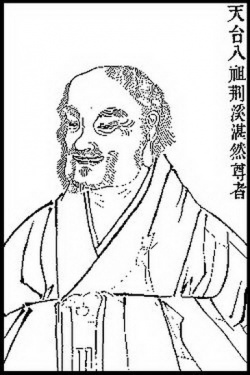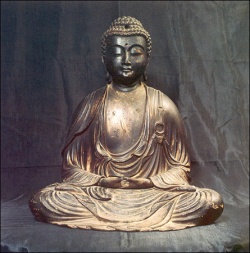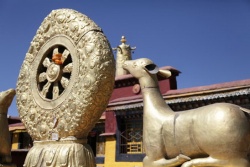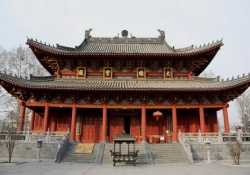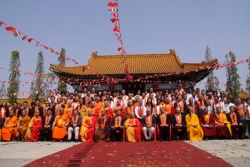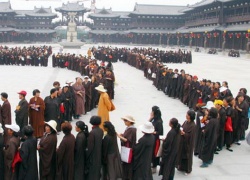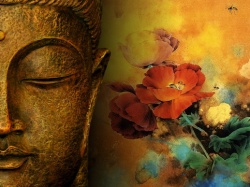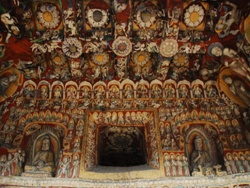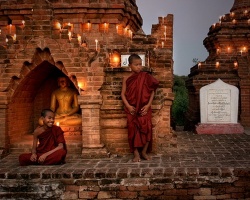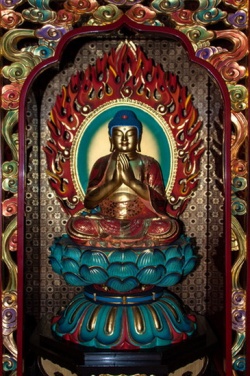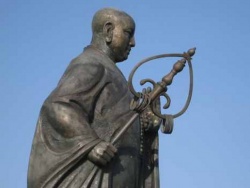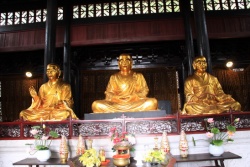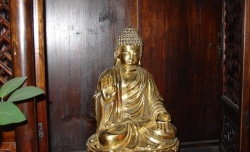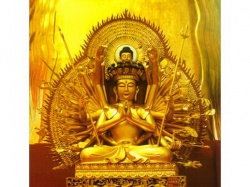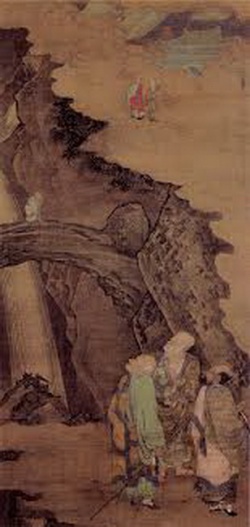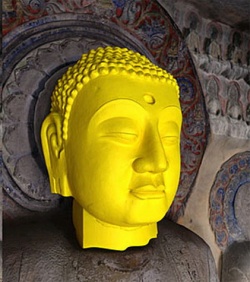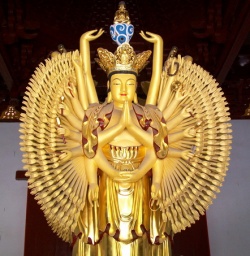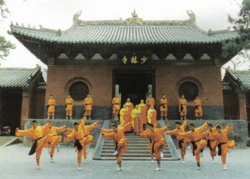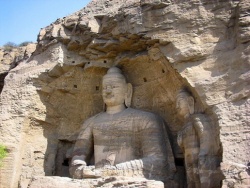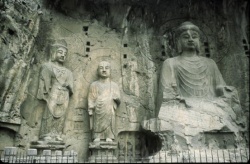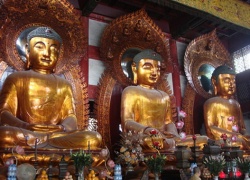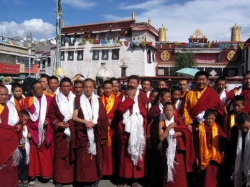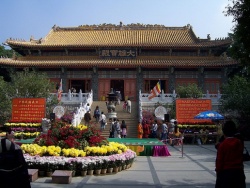Anti-Chan Polemics in Post-Tang Tiantai
HUGH B. URBAN and PAUL J. GRIFATHS
DING-HWA EVELYN HSIEH
Yuan-wu K'o-ch'in's (1063-1135) Teaching of Ch'an Kung-an Practice: A Transition from the Literary Study of Ch'an Kung-an to the Practical K'an-hua Ch'an 66 ALLAN A. ANDREWS Honen and Popular Pure Land Piety: Assimilation and Transformation 96 ROGERJACKSON Guenther's Saraha: A Detailed Review of Ecstatic Spontaneity Anti-Chan Polemics in Post-Tang Tiantai Introduction: Historical Background The period following the death of the sixth Tiantai patriarch Jingxi Zhanran (711-782) has been described as the second "dark age" of Tiantai.1 It was a prolonged state of crisis extending from the Tang into the Five Dynasties and Northern Song, an age marked internalIy by the deterioration of distinctive Tiantai ideas and marked externally by the loss of crucial texts and monastic institutions, especially after the perse - cution of 845 (a period that saw the increased influence of Chan).
Zhanran's reconstitution and revival of Tiantai had succeeded in part on the strength of his incorporation of Huayen "nature-origination" (xingqt) thought2 into the further development and schematization of the "nature inclusion" (xingju )3 conceptions that Zhanran saw in classical Tiantai. Zhanran seems to have regarded this incorporation as a method by which Tiantai nature-inclusion could be reinstated while sublating the Huayen strains of thought which had been gaining ground. 4 After ttl! persecution, however, with the dispersion of texts and loss of institu tional supports, the Tiantal school found itself in need of reconstitution. The non-dialectical and idealistic trend of "tracing principle and cutting off the nine realms of delusion" had come to dominate the world of Chinese Buddhist scholasticism by this time, making inroads into Tiantai thought as well.
This influence is evident already in the teaching of Zhanran's disciple Dao Sui, 5 and becomes more pronounced in syn cretist figures such as Zhi Yuan (768-844) (who studied first at Mt 1. AndO Toshio, Tendai seigu shisia ron, trans. Yenpei fashi (Taipei: Tianhua chubanshe, 1989) 174. 2. The doctrine that phenomenal dharmas "arise from" the buddha nature, but are not inherently included in it, such that it remains forever pure and unde ftled by any detemlinate phenomena. 3. The doctrine that all phenomenal dharmas are inherent to the buddha nature. Both of these conceptions will be explained in more detail below. 4. Ando Toshio 185. 5. AndO Toshio 178. Tiantai and then at Mt Wutai, combining Heze Chan with Tiantai teach ings)6 and Daochang Ningfen (754-828) (who also combined Chan and Tiantai tendencies, and made his home at Mt. Tiantai).7 After tte persecution, the Chan elements of this synthesis came into prominence. Even Deshao (881-972), renowned in his time as a reviver of Tiantai, was closely associated with the Fayen branch of Chan. 8 His student Yongming Yenshou (954-974) took this synctetlc tendency even fur ther, attempting to unify Tiantai, Huayen and Yogacara teachings under the auspices of a form of Chan theorizing emphasizing the "one pure formless mind,9 a notion owing much to the Awakening of Faith, the Perfect Enlightenment Sutra, and especially Guifeng Zongmi's (780- 841) adaptation of the "numinous awareness" of the Heze school of Chan.
Zongmi's infatuation with Heze Chan had all but eliminated the Tiantai influences, especially the notion of the evil inherent in the buddha nature (xing e), evident in the thought of his teacher, the fourth Huayen patriarch Qingliang Chengguan (738-839), who had spent some time studying under Zhanran himself and whose work incorporates elements of both Chan and Tiantai traditions. Zongmi moved the pure undefiled buddha nature, identified with undifferentiated and objectless awareness, to center stage.10 Indeed, as Peter Gregory has shown, Zongmi radically reinterpreted the Huayen tradition, taking away the centrality and ultimacy of "the non-obstruction of phenomenon with phenomenon" (shi shi wu ai) characteristic ofFazang's (643-721) teaching and replacing it with an ultimacy of "the non-obstruction of phenomenon with principle" (li shi wu ai).ll For Zongmi, "principle" was identical with mind" or rather the "numinous awareness" of the Heze line of Chan. In earliest proto-Huayen thought, as found in the works attributed to Dushun, on the contrary, principle equals emptiness.I2 Fazang at times identifies principle with the mind as suchness, and phenomena with the mind of birth and death (a distinction deriving from the Awakening of 6.
. Deshao however appears to have been highly critical of the Chan claim to have a "special transmission outside the teachings," as can be seen from Shimen Zhengtong,juan 5, and Ando 181-2. 9. Ibid. 182-3. 10. Ibid. 184. 11. Peter N, Gregory, Tsung-mi and the Sinification of Buddhism (Princeton: Princeton University Press, 1991) 157-165. 12. Ibid. 1. 28 JIABS 17.1 Faith),13 thereby beginning the trend toward tathagatagarbha idealism that would come to culmination in Zongmi's Chan-friendly teaching. In Tiantai, principle is equivalent to the three truths and practice is centered, as we shall see, on contemplation of not the mind but of the nature of mind (xin xing) as identical with this principle. In Zongmi's own classi fication of teachings, this Tiantai system was made to appear quaint and cumbersome, falling short of a new trend which seemed to have carried the day: the emphasis on the undefiled numinous awareness. To further complicate matters, alternate versions of crucial texts attributed to Zhiyi were being recovered, mainly from Japan, giving normative authority to sometimes diametrically opposed doctrines and assertions.l4 It was in this annosphere that an embattled Tiantai tried to reconstitute itself.
Two opposite paths were taken to meet these challenges. One approach tacitly admitted the superiority of these new elements (the one pure mind, the original absence of defilement, etc.) by claiming that these were originally liantai doctrines. The other approach held that the view of the Tiantai tradition was different from and superior to the Zongmi I Chan view. The first approach was that of what was later polemically designated as the "Shanwaijia (Masters Outside Tiantai Mountain, i. e., the heterodox), while the second was taken by the "Shanjia" (Home Mountain Masters, i.e., the orthodox). It is in the polemics between these two opposed representatives of the Tiantai tradition that some of the most developed liantai critiques of strains of thought identified with Chan are to be found, as they battled each other for the mantle and the name of"Tiantai." The texts left in the wake of such disputes present interpreters with many daunting difficulties. Present day readers may well wonder, when making their way through these writings, what exactly is at stake in these convoluted debates.
It is clear from examining the social and insti tutional setting in which these texts were produced that abbotships, donor patronage, and official imperial support, for example (which were often directly dependent on a monk's prestige and reputation) were at stake. A monk's scholastic reputation was also instrumental in gaining 13. Ibid. 151. 14. The direct impetus of the debates hinged on the long and short versions of Zbiyi's Jinguangming xuan yi, wbicb seemed to imply different attitudes toward the contemplation of the mind. The former versions (embraced by the Shanjia) called for detailed contemplation of all the deluded phenomena of mind, while the latter recommended, for those of highest ability, the direct contemplation of the true mind, ignoring the deluded pbeonomena. See the account in the Fozutongji,juan entrance to the dharma-lineage of a particular tradition, which, once gained, brought material advantages in this life. There were post mor tum benefits from such a position in the lineage as well, for one would be sacrificed to and cared for as part of a dharma line, if, of course, one was considered not to have already achieve enlightenment in this life time.
Furthermore, the authority granted by the tradition's validation of one's achievement (represented by one's final place in the gallery of dharma-ancestors) would fulfill one's "filial" obligations to one's teach ers as well as one's vows on behalf of one's "descendants!' All of this was something worth fighting for, especially if the prestigious dharma heirship of a particular line of transmission that carried with it a certain degree of prestige became a matter of scholastic dispute. By means of a highly arcane discourse, the members of a particular class of monks were able to define themselves and maintain their positions by excluding those who had less perfectly mastered its literary conventions, thereby maintaining their position, their niche in the food-chain, and their monopoly on their particular type of power. Their texts, of course, represent the stakes of these disputes very dif ferently. According to their own declarations, the participants in these debates were seeking the accurate transmission of the experience of truth discovered by Sakyamuni, clarifying the highest teaching, contributing to the salvation of all sentient beings. They claimed to be seeking and explicating the truth, a truth which had soteriological significance.
Understanding and practicing in accord with this truth would lead to enlighterunent and liberation from samsara. In their endeavor to clarify this salvific truth, these polemicists systematically developed philosophi cal positions, which they were forced to explicate in much more rigorous detail than was the custom under less contentious conditions in China. These claims have a considerable philosophical interest in their own right Yet even from this perspective, the import of the texts is far from clear, and it takes some patience and induction to unravel the implica - tions of some of the Song and post-Song Tiantai polemics against cer tain aspects of the Chan tradition. Most of these polemics emerged as a kind of overflow from the in fighting between the two contending branches of the Tiantai tradition referred to above. According to the texts that passed between represen - tatives of these two branches, the Shanjia felt the Shanwai had been unduly influenced by Huayen and Chan, especially by Zongmi (with his Huayen-flavored version of Chan "doctrine" or Chan-flavored version of Huayen doctrine), thereby polluting and diluting the distinctive, and 30 JIABS 17.1 moreover, true and salvific Tiantai tradition. Almost all of the attacks on Chan "doctrine" discussed below appear in the context of this Tianuu in fighting, focusing particularly on Zongmi's version of this doctrine, a version especially influential among the Shanwai exegetes.
Where Chan is attacked directly (for example, in the works of Siming Zhill [960- 1028], the most eminent and vitriolic advocate of the Shanjia position), it is typically presented as a counterattack, with allusion to Chan sympa thizers having disparaged Tiantai as inferior to the teaching of Zongmi and his sympathizers. IS The Chan tradition itself is accepted by Zhili as a legitimate part of the Buddhist heritage, and thus has its place, like other teachings, in hisjiaopan (classification of teachings): it is part of the "special teaching" (biejiao). Zhili seems to have no particular vendetta against Chan per se; 16 he is annoyed only when claims are made that it surpasses the Tiantai "perfect" or "rounded" teaching (yuanjiao). Main Points of the Tiantai Critique The critique put forward by Zhili and his followers attacks Chan on a number of distinct but related fronts, which may be summarized as follows:
1. The excessive emphasis on meditation at the expense of doctrine, allegedly advocated by many Chan masters, was disparaged. The Tiantai polemicists claim to value doctrine and meditation equally. 11lis issue has little real content; it was for the most part a mechanical comparison of the slogans of the two traditions, with little interest in the actual content of these slogans. Indeed, there was far greater attention given to the precise mechanics of sitting meditation in Tiantai than there was in Chan.
2. 1be Tiantai exegetes were harshly critical of Chan's alleged rejec tion of words, which grew, they said, out of a failure to see that words are a necessary vehicle to enlightenment. Although it can be argued that Chan writers advocated nothing of the kind (or at least had more 15. See for example Zhili's correspondence with Chan Master Tiantong Ning in Siming jiaoxing lu, (Taisho 46, 891-897 [=T. 46.891-897]) 16. Indeed, as Wang Zhiyuan has pointed out, there is evidence that Zhili's teaching technique was deeply influenced by methods we would now associ ate strongly with Chan, e. g., shouts and blows leading, according to the hagiography, to sudden enlightenment experiences. See Wang, Sungchu Tiantai Foxue qinmao (Beijing: Zhongguo jianshe chuban she, 1989) subtle understandings of it than what was portrayed in Tiantai this polemic), many in the Chan tradition did seem to take the famous slo gan about "a special transmission outside the teaching, not depending on words and letters" in a way that would not have been satisfying to a Tiantai exegete.
Also involved here is a charge of a fundamental misunderstanding of the whole concept of upiiya, which is central to the Ttantai view of the ultimate reality. In traditional Tiantai, the truth to be realized itself includes both the means to its realization and the process of realization. The three-fold buddha-nature described in the Nirvii!la Sutra are the three causes of enlightenment: (1) the cause proper (zhengyin), that is, the objective truth to be realized, (2) the "revealing" cause ( liaoyin), the process of coming to know this truth, and (3) the "conditioning" cause (yuanyin ), the process of coming to act according to this truth, and in such a way that furthers one's knowledge of it. These cannot be subtracted from the final effect, buddhahood, without causing a misapprehension of its fundamental nature. Indeed, the tenn "buddha-nature" must be taken to include all three of these aspects.
The doctrine of upiiya as expressed in the wtus Surra, as interpreted by Zhiyi, the de facto founder of the Tiantai tradition, is also important here: the perfect teaching is typically distin guished from the special teaching in that the former "opens up" all previous upayas to "reveal" their ultimate truth (kaiquan xianshi). This is taken to mean that the perfect teaching sees all the upayas as necessary parts of the ultimate truth and its realization, inseparable from it and indispensable, such that all of them are "upiiya which are intrinsic to the entity (of truth) itself (tineifangbian)." Part of what enlightenment consists in, according to this view, is an understanding of the entire Buddhist tradition itself (i.e., panjiao), in other words, how all the teachings, sutras, upiiyas, fit together into one coherent whole with one single flavor of enlightenment throughout.
Such an understanding obviously depends strongly on the existence and understanding of specific texts. 3a. The Shanjia exegetes were critical ofZongmi's version of Chan doctrine (putatively representing the Heze line of Shenhui), which cast this doctrine in terms of Huayen thought, because it depicted all phe nomenal reality as included in buddhahood, but only indifferently. In other words, for Zongmi, all that is, whatever it is, is the ultimate real ity, the unchanging dharmakaya, subject to various conditions (suiyuan) (the finite determination of which is external to the dharma kaya). The various differentiated things in the world are the dharma- 32 JIABS 17.1 Uya. Here the fundamental model of wave and water is stressed. All waves are water, but the specific shapes of the different waves is not what is "watery" about them. It is irrelevant what shapes there are; it would be equally water whether or not there were waves. For the Shanjia, however, all that is, as it is specifically, is the ultimate reality, the dharmakaya.
It is the nature of ultimate reality, not merely to assume any shape at all, but to be precisely these ten realms,l 7 these three thousand suchnesses. 18 Buddhahood inherently includes all the other realms, all the other finite determinations in the universe. This makes the Shanjia in one sense much more firmly attached to tradi tiona! Buddhist cosmology; it is the Buddha's nature to be these ten particular realms, with their ten particular suchnesses, etc. We are told not only that anything is the Buddha, nor only that everything is the Buddha, but rather that Buddha is this everything that can be delimited into three thousand suchnesses. We are told what Buddha is, not only that he is whatever there is. The absolute is not to be conceived as an indifferent, indeterminate blank, capable of taking on any finite detennination that happens to come its way, as Zongmi's mirror anal ogy and mind metaphor suggest Its nature is determinate; it is pre cisely the world that is the absolute, nothing more and nothing less. Distinctions and determinations are not merely an effect of delusion; they do and should exist. They are, in fact, part of the substance of 100 dharmakaya, which differentiates itself and comes to know itself in all its finite determination, by means of this process of delusion and sub- 17. The realms of purgatory, hungry ghosts, animals, asuras, humans, devas, sravakas, pratyekabuddhas, bodhisattvas and buddhas. 18.
There are ten "sucbnessness., (rushi) to each realm: appearance, nature, entity, power, activity, primary cause, secondary cause, effect, response, and consistency from beginning to end. The terms come from Kumarajiva's translation of the "Upaya" chapter of the Lotus, and come to be applied to each realm by Zhi Yi in the Fahuaxuanyi and elsewhere. There are said to be three thousand suchnesses because each realm contains all the others (10 x 10), each of which has the ten suchnesses (X 10), all of which is applied to the world as skandhas, as sentient beings or as physical environment (X3). 10 X 10 X 10 X 3 =3,000. The "three-thousandness" in particular is sttessed by Zhili, as his renegade disciple Renyue derisively noted after going over to a modified Shanwai position. The specificity of this three thousand in the thought of Zhi Yi is much more problematic, as can be seen by his treatment of the Ten Thusnesses in the Fahua xuanyi, where they are treated as one scheme among many for categorizing what exists. Zhi Yi says, in effect, that all things can be integrated into one dharma (mind), or two (name and form), or three, or four, or a hundred million, as you wish, but the Lotus does it according to these ten sequent enlightenment, which do not fall outside of it As Zhili puts it, "Our teaching makes clear that the substance with its three thousand dharmas follows various conditions to give rise to the Function (phenomena) with its three thousand dharrnas. When it is not follow ing these conditions, the three thousand are still there just the same. Thus the differentiated dharmas and the substance are not two, because even when delusion is eliminated, the distinctions remain ."19 3b. Strenuous exception was taken to Zongmi's version of the Chan doctrine of the status of mind, which Zhili considers to have been a corrupting influence on the so-called Shanwai Tiantai monks. The point of contention is whether mind, however construe<L has some special ontological status among all dharmas, as their source or ulti mate ground, or whether it is in principle on equal footing with any other given dharma.
The latter is Zhili's position, and he interprets the statements about the primacy of mind in Zhanran and Zhiyi to refer to a particularly effective meditation technique, selected because mind happens to be what is closest to the practitioner. Mind, here, is the ordinary, deluded mind of one who has not yet practiced meditation, rather than a purified or original mind. The mind is indeed the "source" of all other dharmas, to which everything can be reduced and by which everything else can be explained, but the same could be said of any other dharma, including any speck of dust or sound or smell. To contemplate mind is the easiest way to come to this understanding. Zhili alleges that the Shanwai have adopted the provisional "special teaching" (biejiao) of the Huayen school, which is also Zongmi's version of the underlying doctrine behind Chan's "special transmis sion." Indeed, the "mind" that is transmitted through the Chan lineage is this pure, ontologically ultimate mind, according to Zongmi. 4. The Chan lineage claimed a special authority deriving directly from Sakyamuni himself and forming a special transmission of the buddha mind outside of that recorded in the sutras. The 1iantai polemicists hold this claim to be historically unfounded and religiously misguided. Siming 7lrili's Critique ofGuifeng Zongmi: Three Types of Identity Between SlllJlSlira and Nirvlil)a Let me explicate these points now in greater detail.
Zhili explicitly tar gets Zongmi and his version of the Chan lineage and doctrine in the fol- 19. Zhili, Shi buermen zhiyao chao, T. 46.715b. Emphasis added. 34 JIABS 17.1 lowing passage from the Shi buermen zhiyao chao ("Notes pointing to the essentials of [Zhanran's] 'The Ten Gates of Nonduality"'): Question: It bas been passed down to us that three of Bodhidharma's dis ciples attained the dharma, but at different depths. Nizongchi said, "[Your teaching is] to cut off defilements and realize enlightenment." The master said, "You have got my skin." Daoyu said, "Deluded, it is defilements; enlightened, it is enlightenment." The master said, "You have got my flesh." Huike said, "Fundamentally there is no defilement; it is originally enlightenment." The master said, "You have got my marrow." [Your] pre sent [thesis], that "Defilement is identical with enlightenment," and so on, seems to be the same as the "skin" and "flesh views. How can it be called unsurpassabl y perfect and sudden? Answer: Scholars of our teaching, because of these words, are confused by names and miss the meaning. To use that to make determinations about this entraps and dissipates our teaching. Truly, it is because they do not exhaust the meaning of the character ji ("identical").
It should be made known that our understanding of "identical" is forever different from that of all the [other] teachers. This is because [for us] it is not a matter of two objects joined together, nor of two sides of something turned over. Rather, to be called "identical," this very substance [before us, just as it is] must be completely [the other] (dangti quanshi). And why? Defilement and sal!lsara are manifested [lit., practiced] evil (xiu e); their whole substance is the dharma gate of inherent evil (xing e). Hence there is no need to cut off and excise them, nor to tum them over. Since the other schools do not understand inherent evil, they need to tum evil into good, or cut off evil and realize good. Thus even the "extremely sudden" still say, "Fundamentally there is no evil; it is originally good." Since they are not able to take the complete [manifested] evil as [inherent] evil, none are able to perfect the meaning of "identical." Thus (Zhanran) says in the M iaofa xuanhuajing xuanyiji,juan 7, "Since in their carelessness they have never even heard the name 'inherent evil,' how could they believe there is such a thing as the practice of inherent meritorious properties (xingde zhi xing)?" [Question]: In that case, why not say "Defilement is identical to defile ment," and so on? Why do you speak instead of enlightenment and nirvaJ:ia? Answer: Truly it is not a separate meaning; it is just because inherent evil is all-penetrating and all-fusing, and quiescent, that it itself is given the names enlightenment and nirvli!lfl. These names are set up [for this inher ent evil] from the point of view of the ultimate truth. How is this similar to the "skin" and "flesh" views? Moreover, since defilement and so on are completely inherent evil, bow could one just say categorically, "Fundamentally, there is none"? But this story you have quoted, where Bodhidbarma gives his seal [authorizing genuine dharma transmission] to Master Ke, with his "Fundamentally, there is no defilement. it is originally enlightenment" and so on, is all Zongmi's heretical explanation, which has led later people to take this as the ultimate, thus abandoning the three [evil] paths20 and only contemplating the "true mind." The Zutangji just says, "The second patri• arch bowed three times, and stood in his positioo."21 Where does he say that defilement exists and enlightenment does not? Thus we should not use Zongmi's heretical explanations to make determinations about our school's marvelous doctrines.22 20.
The "three paths" (san dao) is a peculiar Tiantai expression, used by Zhi Yi to refer to du kha, karma and kle/a, and thus to defiled, unenlightened samsAric existence as such. These three are meant to cover the entire nidana chiin, with ignorance, attachment and appropriation comprising "kleta," dis sitions and becoming comprising "karma," and the rest comprising 'duflkha." The three paths are identical to the three tracks and finally to the three virtues of enlightenment (dhannakaya, prajf1A and liberation). They are not to be confused with the three lowest paths of samsara (usually called santu in these contexts), i. e., purgatory beings, hungry ghosts and animals. Zhili's point here as that evil, deluded existence, the deluded mind, must not be abandoned in meditative praxis; ralller, it is to be tbe focus of that praxis, the nature of which is to be revealed and realized rather than left behind. 21. The extant version of the Zutangji includes neither version of this story. Instead, Bodhidharma simply states that these three disciples had attained his skin, flesh and marrow respectively, and moreover prophesies that his dharma heirs will begin to get worse and worse after six generations.
(See Feng Minzuo, Chan yulu, vol. 2 (Taipei: Xingguang chuban she, 1982) 551. In the Jingde chuandeng lu, juan 3, the story appears as follows: "Bodhidharma said w his disciples, 'The time is at band; let each of you speak of wbat you have attained.' Daofu said, 'As Iunderstand it, to neitber cling to language nor leave language behind is the function of the way.' The master said, 'You have attained my skin.' Nizongchi said, "As I now comprehend it, it is like beholding with joy the buddha-land of Ak bhya, which one sees only once and then never beholds again.' The master said, 'You have attained my flesh.' Daoyu said, 'The four great elements are all empty, the five skandhas do not exist, and so, as I see it, there is no dharma that can be attained.' The master said, 'You have attained my bones.' Finally, Huike bowed, and then stood in his position. The master said, 'You have attained my marrow."'
This version of the story seems to derive from tbat which was available in Zhili's time. 22. In the Taislw the original version says: "This transcends even the expla nation that 'got the marrow.' Even if the intention bebind Master Ke's view was based on this, the way of expressing it was imperfect Question: In your present explication of the perfect teaching, how could it be that you do not speak of cutting off delusion to realize principle, and of turning over delusion 36 JIABS 17.1 Now we speak of "cutting off' from the point of view of this identity, so there is nothing to be extinguished. We speak of enlightenment from the point of view of this, so there is nothing to tum over. Defilements and sarp.sara are the dharmas of the nine realms [of hell beings, hungry ghosts. asuras. animal, humans, devas, !ravakas, pratyekabuddhas, and bodb isattvas]. Since [the teaching] is only called perfect if the ten realms [of the above nine plus the realm of buddhas] mutually inhere and contain one another, how could the buddhas destroy or transform the nine [other realms]? Only thus can [the Buddha] be said to "have mastery within evil" and only then can it be said that "The realm of the demons is itself the Buddha." Thus the perfect teaching's cutting off, realization, delusion, and enlightenment are spoken of only with respect to [subjective] taint [i. e., attachment] and purity. not with respect to [objective] good, evil, purity, or impurity. Since the other teachings do not understand that the [buddha-] nature inherently possesses all ten realms, they lack the perfect [teaching's understanding of the] meaning of cutting off and enlightenment. Thus they have attained the word "identical" but not the sense. This is the great path of the whole teaching of our school. 23 This passage sets forth the doctrinal foundations of the Shanjia case against Zongmi's version of Chan, but it will be necessary to untangle Zhill's own doctrinal position to get a sense of what exactly he is object ing to here. Zhili's dilemma is that one of the positions that Zongmi's Chan (represented here by Huike) claims to have transcended sounds very much like the Tiantai position. Zhili must in effect prove, first of all, that there is no genuine scriptural authority for the story that Bodhidharma approved of this evaluation of the relative merits of the teachings.
The fact that he bothers to do this suggests that Bodhidharma to approach enlightenment? If you do speak of these things, how is it any different from Cbiyu's explanation? Answer: How could it be, even with Master Ke, that there is no cutting off or overturning of delusion? And yet bow could that make his view the same as that of the former two? Thus we can know that whenever there is talk of divisions between gradual and sud den, it is a matter of the motivations and methods of the cutting off and over turning." According to the Siming zunzhe jiaoxing lu (T. 46.896c), Zhili replaced this passage from the original version with the passage beginning. "But this passage you have quoted ... " after Zhili's correspondence with the Chan master Tiantong Ning. The new passage identifies the source of the quotation, which had been contestecL and at the same time more specifically targets Zongmi. The target of the attack is not Bodbidbarma, Huike, or the otber luminaries of the early Chan lineage, but rather Zongmi's later miscon strual thereof. Zbili claims that Zongmi put forth the version refuted here in his Guzfeng houji. was to him a figure whose autllority mattered, while Zongmi was not. lbis is important, for it indicates the underlying ambivalence of Zhili's polemic against what we are here calling "Chan." For it seems that he is not targeting the entire Chan tradition and everyone in it, nor even every explicit doctrine of those included in this lineage, which are quite multi farious.24 Rather, it is Zongmi's authority and doctrine which are ques tioned.
He has no authority to speak for the tradition, Zhili asserts, and moreover his own doctrine is fundamentally wrongheaded. It is he who arbitrarily characterized and ranked the teachings in this way, and he is not to be trusted.2s Zhili's Critique ofZongmi's Concept of Mind In particular, Zhili objects to the influence of Zongmi's idea that "The one word 'awareness' (vu) is the gate to all marvels:' and that "What Bodhidharma transmitted was just this numinal awareness (lingzhi) and nothing more."26 Let us look at this objectionable doctrine ofZongmi's in more detail. In the Chanyuan zhuquanji du xu, juan 2, he writes: All sentient beings have the empty, quiescentrue mind, the nature of which is naturally pure from beginningless time, bright and undarkened, clear and ever aware. Ever dwelling undestroyed throughout future time, it is called the buddha-nature. . .. This awareness is not the same as that involved in coming to realize or know something. The point [of calling it awareness] is to make clear that the true [buddha] nature is not the same as empty space or trees and stones; hence it is called 'awareness.' It is not the consciousness of following objects and making distinctions, nor is it the wisdom which reflects on the essence and fully comprehends it.
It is sim ply the single nature of true suchness, which is spontaneously always aware. Thus the bodhisattva Asvaghosaid, "True suchness is in its own substance true and substantial, conscious and aware." ... Wisdom and 24. Indeed, the authority of Yongjia Xuanjue (675-713), a figure associated with both Tiantai and Chan teachings, is respected elsewhere in this same text, and great pains are taken to show that Zhili is not contradicting him. Zhiyao chao, T. 46.709b. 25. Indeed, Zhili's contemporaries also noticed that this rejection of Zongmi did not entail a refutation of Chan as a whole. The Chan master Tiantong Ning, in his correspondence with Zhili, seems, if I understand him correctly, freely to admit that Zongmi's works contained many contradictions, and moreover that he had unjustly exalted Heze Chan and underemphasized the teachings of Niutou Chan. See Jiaoxing lu, T. 46.895. 26. Both statements can be found in Chanyuan zhuquanji du xu, juan. 2 (T. 48.405b). Tiantong Ning seems to be in complete agreement with Zhili on this objection to Zongrni. 38 JIABS 17.1 awareness differ in that wisdom is restricted to the sages and does not reach to the ordinary, whereas awareness is possessed by everyone, sage or ordi nary....
The Ratnagarbha Slistra says, "Knowing being is perishable, knowing non-being is corruptiblen-this is all merely the wisdom which knows being and non-being-"but knowing uue awareness does not recog nize being or non-being"-since it does not recognize being and non-being, it is the non-<liscriminating awareness of the self-nature. The mind of numinous awareness thus revealed is the true [buddha] nature, no different from the Buddha. . . . This is the 44third type" of Chan in its entirety directly revealing tbe mind-nature. . . . Why tben do the partisans of "destroying marks" [such as Madhyamika) only speak of quiescence and disallow the teaching of true awareness, while the specialists in "explaining marks., [such as Yogacara) cling to the notion that the ordinary differ from the buddhas, and will not allow tbe teaching that [ordinary beings] are iden tical to the Buddha? ...
This teaching uses the single true mind-nature to transcend and also to encompass all tainted and pure dharmas. It transcends all as discussed above: it is concerned only with the substance, directly pointing to the numinal awareness, which is the mind-nature. Everything else is delusion. Thus it is said, "It is not cognized by consciousness, not an object of the mind," and so on, up to, ' ot a nature, not a mark, not the Buddha, not sentient beings, apart from the four possible propositions, cut ting off all negations." It encompasses all in that all the tainted and pure dhannas are mind. When mind is deluded, it delusively gives rise to karma, tbus leading to lbe four types of birtb and the six paths of existence, and all the impure lands and realms. When mind is enlighteneit gives rise to function in accord with its substance, the four virtues [kindness, pity, joy, and equanimity] and the six perfections, and on to the four differ entiations and ten powers, marvelous bodies and pure lands, all manifest in it. Since this mind manifests all dharmas, all dbarmas are entirely identical (quan ji) to this true mind.
It is just as when a person dreams: all the things be manifests in the dream are that person himself. When vessels are made from gold, all the vessels are gold; wben images appear in a mirror, all the images are tbe mirror.27 1llis awareness, also called the true mind, for Zongmi transcends being and non-being, good and evil, all of which however it manifests or "creates" as the objects of its awareness. At the same time, it is carefully distinguished from ordinary discriminating consciousness, the appre - hension of external objects, logical thought, and from the specifically enlightened consciousness of the Buddha. All these particular forms and characters are manifested in and by it, but by clinging to or concen trating on them, one misses the awareness itself, which is at the base of them all. The absolute nature itself is characterless and quiescent, differ ing in substance from all phenomena, and hence neither sacred nor pro fane, good nor evil, and so on. Deluded thoughts and enlightenment are both equally manifestations of this mind, equally dependent on it and transcended by it As Zongmi puts it, "The dao is the mind itself. . .. Evil is the mind itself." 'The mind is ever aware and this alone is important; whatever the object of awareness is, it is illusory compared to the mind. The object derives its importance and its reality solely from the fact that it is mani fested in the mind, which alone is the Buddha It is true that all phenom ena are thus nothing but the absolute nature, that is, the mind, but this is not because of what they are in particular, but only because whatever they are, they are actually just this mind, which is the absolute. This is Zongmi 's interpretation of "understanding that all characters are no char acters"-all specific characteristics are reduced to illusory configurations of the mind, which alone is real. Objects are real in their substance, which is mind, but unreal in their qualities.
As Peter Gregory puts Zongmi's point, "[T)his doctrine meant that all phenomenal appearances {hsiang [xiang]) only had reality insofar as they were seen to be mani festations (ch'i [qi]) of the nature {hsing [xing])." 28 Thus one can see the Buddha everywhere, not so much because the Buddha "is" every where, but more importantly because seeing itself is the Buddha. The Buddha is seen equally in each object, the same operation is repeated over and over. Hence he can say, "Originally there is no defilement." for impurities, the differentiations of things, the suffering of finitude, are all illusory manifestations of the true mind itself; all of them are only real in that they are mind, which is in reality all they have ever been from the beginning. Hence, "Originally it is enlightenment" The true awareness, the mind, is in and of itself devoid of all characters, but all characters are manifest in it lhis mind is to be understood directly from one's constant experience of it. Intellectually, however, "mind" is not a simple concept, but rather a complex of ideas, and this way of speaking, saying that all things are the manifestation of the true awareness, suggests how the world is to be encountered. The fact that the absolute is characterized as "mind" implies that its relationship to all finite things is analogous to the rela- 28. Gregory 251. 40 JIABS 17.1 tionship between a perceiving mind and the things it perceives.
The single perceiving mind is complete in each of its many perceptions. It "negativizes" (i. e., de-absolutizes) them, "transcends" them as Zongmi puts it ("not a nature, not a mark/' etc.), for whatever it perceives is only a perception, rather than the mind or the thing itself; everything in mind is a relation; a perception is a manifestation of the relation between the object and the mind; everything in it refers to something outside itself. It is always aware, and yet always must be aware of something. 1be mind, in ordinary perception, both is and is not all the things it perceives, and those perceptions are both it and something else. In Zongmi's descrip tion of the situation, all objects are both posited and superseded by the absolute, in the same way that objects are both posited and superseded by the perceiving (but not the cogitating) mind. The mind can abstract from any of its perceived objects and still be the mind, and yet all the objects are in the mind. In order to be itself, the mind is therefore not dependent on any of its objects, and yet it must have some object.
How ever, the objects retain their independence-that they appear is due to tre mind, but not what they appear as. lbis is understandable in the case of the metaphor, the ordinary perceiving mind, but in the case of the abso lute, we are left to wonder where these particular determinations come from. The principle of relativity is here constricted to the dependence between mind and objects; the mutual dependence of objects, which gives them their particular characters, is left out of the account. Zongmi of course claims that the absolute, the mind, produces the individual forms it manifests, due to "deluded thoughts from beginningless time"; the mind is itself neither enlightened nor deluded, but can be enlighten ment or delusion. Still, the manifestation of enlightenment is "the arisal of function in accord with substance," while the manifestation of delu sion is the "confused production of karma:' There is some sense in which the substance is more similar to the enlightened manifestation than it is to the deluded manifestation, although it is the same mind in either case. The inner nature of the absolute bears a closer resemblance to some of its manifestations than to others, and this would seem to sug gest that it is in fact "marked" by certain characteristics, leaving the deviations from these original characteristics inadequately explained. For Zhili, this is not the ultimate teaching, although it does have a place among the legitimate doctrines of Buddhism. It is one form of the "special teaching,,. the second highest of the four general divisions of the Buddha's teachings, according to Zhiyi's classification of teachings. It falls short of the perfect teaching for two main reasons. First. it gives Special status to something called mind or awareness.
True, the claim is made that this mind has no characteristics, i. e., is not a "something" at all, is no particular dharma. Nonetheless, it is described as manifest in certain types of actl vity, for example, in the sentience of sentient beings, as perceptivity, which is a certain type of dharma, although perhaps a J>eculiarly problematic one, as discussed above. This distinction goes back to Zhanran's doctrine (put forth in the Jingang Bei) that inanimate Objects possess the buddha nature, a doctrine which would seem to pre sent difficulties for this identification of the buddha nature with the activity of awareness. For the Tiantai school, as Zhili interprets it, the budcllla nature is not to be identified with the any dharma simply called "mind" or "awareness." It is conceived first and foremost as the three truths: emptiness, provi sional positing, and the mean (kong, jia, thong). These are interpreted in different ways in each of the four teachings. In the perfect teaching, these three truths are claimed to be of equal value, none more "ultimate" than the other two.
Each is said to imply the other two, and any two can be reduced to the other one. Emptiness signifies the lack of self-nature due to conditioned arising. Provisional positing signifies the condi tioned arising due to lack of self-nature. The mean signifies the harmo nious conflict or non-obstruction of these two opposed points of view, the fact that they express exactly the same thing, while still being opposites. The special (or separate) teaching is said to cling to "only the mean" (danzhong), a view of the union, and thus transcendence, of these opposites. The absolute is understood in the perfect teaching, on the Other hand, to be "not only the mean" (budanzhong), a unity of oppo sites in which the opposed pair remain opposed although reconciled, "sublated" rather than left behind. Any one of the three truths brings With it the other two; one cannot speak of emptiness without thereby admitting provisional positing, and its harmony with emptiness. One cannot speak of provisional positing without thereby admitting empti ness and its harmony with provisional positing.
According to Zhili, the truth of provisional positing in the perfect teaching signifies, more specifically, neither the conditioned arising nor merely the "establishment" or positing of dharmas, as in the lower teachings, but rather "inherent inclusion," (ju), the integration of all dharmas by each dharma, the fact that each dhanna "avails itself' (jia) of all other dharmas 42 JIABS 17.1 to become what it is.29 1bis is the basis of the claim, found in Zhiyi's Sinianchu and derived from the prajiilipiiramitii sotras, that "all dharmas go to [i.e., are reducible to] form, to scent, to each speck of dust," etc., so that we can speak of "form only, scent only, sound only" as well as the more usual "consciousness only." Consciousness is emphasized only because of its greater utility for purposes of contemplation and cul tivation. As Zhili puts, any dharma, chosen at random, is the totality, the single unifier of all dharmas ( Suiju yifa jie de wei zong).30 Any given dharma is thus to be regarded as (1) thoroughly negated (other-referenced, passive, dependent), and also as (2) provisionally posited as a certain particular entity with specific characteristics, and at the same time, one is to see (3) the perfect harmony, indeed mutual implication of these two views of the same dharma To view the perfect harmony is to preserve the particular characteristics of a given dharma while seeing that this phenomenon is the center and essence of every thing else, a self-creative power, the one explanatory principle to which everything else can be reduced, availing itself of everything else (self sufficienindependenirreducibly what it is).
These three truths are correlated in Tiantai with "the three tracks" (sangui), i. e., the track of subjective consciousness (guanzhao, con templation), action (zicheng, literally, what is depended on for becoming and completion, i.e., practice) and objectivity (zhenxing, the true nature). In Zhiyi's Jinguangming xuanyi, ten triads are correlated, representing ten stages along the three tracks. 31 Each triad, therefore, contains ore member correlating with each of these three general ideas: subjectivity, action and objectivity. 'These range from the "three paths," i. e., karma (action), defilement-vexations (subjective consciousness) and suffering (objectivity, i. e., the truth about what exists), to the three buddha natures: the active cause (yuanyin) of the achievement of buddhahood, the revealing cause (liaoyin) and the objective cause (zhengyin), and finally to the three virtues: liberation (action), prajfla (subjective con sciousness) and dharma.kaya (objectivity). 32 Here we see all phenomena analyzed into an omnipresent trinity of action, subjectivity and objectivity.
The moment of negation, of emptiness among the three truths, is correlated with subjectivity, provisional positing is correlated 29. See Zhili, Siming shiyi shu, T. 46.836a. 30. Zhiyao chao, T. 46.708b. 31. The ten triads are also discussed in the Fahua xuanyi, T. 33.744a 32. See Wang Zhiyuan, Sungchu Tiantai Foxue qin11Ulo (Beijing: Zhongguo jianshe chuban she, 1989) 16-25, for a fuller discussion of these ten trinities. ZlPORYN 43 with action. Their mutual non-obstruction and inclusion, the mean, is the element of objectivity, the ultimate truth about them. The three truths give us the inner structure of all the tenns in the three tracks, understood in terms of the root idea of conditioned arising. The status of mind is conceived very differently here than it had been by Zongmi. The phenomenon of awareness as manifested in human beings and other sentient beings is a form of one of the three tracks, subjective consciousness, necessarily bound up with and implying the contrary tracks of objectivity and action, each of which also implies the unification of the other two.
All of these are regarded as unfoldings of the implications of the simple doctrine of conditioned arising. Hence consciousness has no special or prior status relative to physical form, or to anything else. It is indeed the absolute itself, but this is equally true of any other given dharma. Indeed, the only consciousness experienced is not a "numinal awareness," but something thoroughly conditioned, and it is precisely this fact that makes it "marvelous"; it is this conditioned ness that is the basis of all the three truths as manifested in everything. The momentary joining of object and sense organ in the deluded con sciousness makes this consciousness a useful object of contemplation. Zongmi says of the numinal awareness, "the mind is self-knowing, not dependent on conditioned arising, not arising due to the object The one word awareness is the gate to all marvels."33 But this would make it a useless object of contemplation for Zhili, since what is to contemplated is precisely conditioned arising and the necessary implication of all three truths and all they entail.
The goal of all practice and contemplation is to see the three truths, not to see mind, which is just a special instance thereof. lbis is a point of great importance for Zhili: Zongmi's doctrine is pernicious because of its negative effect on practice. To enjoin begin ners to contemplate the true mind is to cut off their entry into the truth, for the purpose of completed contemplation and practice is finally to per ceive this true mind, which is necessarily also to perceive true form, true scent, true skandhas and so on. Tills absolute is indeed everywhere, as "even a child knows," but this is merely the "identity of name," (the first and lowest of Zhiyi's six levels of identity between samsara and nirvana) not the final identity of realization (the last). Zongmi describes the cultivation of this "awareness": 33. Zongmi, Chanyuan zhuquanji du xu, juan. 2. (T. 48.405b) 44 JIABS 17.1
Non-cutting, non-cultivating, freely following [the mind-nature]-only this is called liberation. The nature is like space, neither augmented nor dimin ished; what need is their to add to or repair it? Simply extinguish karma in all times and places and nourish the holy embryo, and it will increasingly manifest, naturally divine and marvelous. This is true awakening, true cul tivation, true realization. . . . Awareness is without any [[[Wikipedia:determinate|determinate]]] thought or form-where then can there be any mark of self or othec in it? When one realizes that all marks are empty, the mind is without thought. When a thought arises, one becomes immediately aware of it, and once one is aware of it, it becomes nothing. The marvelous gates of practice all depend on this.... After one realizes that all marks are no marks, one nat urally cultivates without cultivation ..."34 The essence of cultivation is here portrayed as seeing that any determi nate fonn or thought that might arise in consciousness is actually nulli tied because it can be seen as simply the mind itself, rather than that par ticular fonn.
The mind itself is without any detenninate character. To see that all determinations are manifestations of this indetermination (marklessness) is enlighterunent; this is to reduce the particular determi nations to indetermination, giving them value only in that determination per se is in fact a manifestation of indetermination, and hence is the absolute. This absolute is equally accessible through any perception, and the procedure in any case is the same: to ignore the determination itself (see it as "no determination," "no mark") and reduce it to the markless mind. What particular thing it is simply does not matter. The recognition of this ever-present awareness is, according to Zongmi, what all the Chan patriarchs up to Shenhui had been obliquely indicating, and it was what Shenhui openly proclaimed, because he could not find any one of sufficient karmic acuity to understand it through silent direct pointing.3 s In the elaborate meditation techniques advocated by the Tiantai patriarchs, attention is directed specifically to particular types of phenomena, dealing with them in their finite determination and offering a different analysis of each, showing how this particular dharma is a manifestation of the structure described by the three truths.
To claim that one need only be constantly mindful of this mind is to imply that these techniques are unnecessary. Such an implication is unacceptable to Zhili. The authors of these polemics, both Tiantai and Chan, accepted many of the same texts, but interpreted them according to their school's indi vidual doctrines. Thus, Zhili and Zongmi would agree on the identity of defilement and enlightenment. Zhili's point in his critique of Zongmi is the mere claim of identity tells us very little because it can be taken in a wide variety of ways. When Zongmi claims that all things, every scent and sighare the absolute, he is, according to Zhili, taking this to mean that since they are all actually mind, and mind is the absolute, scent and sight are the absolute. That is, they are mediated by another term, mind, in attaining their status as absolute. 1bis speck of dust is absolute, not in that it is a speck of dust, but in that it, like everything that manifests, is manifested in mind, has no being other than that of the mind, and hence is absolute. 1llere is nothing absolute about "dustness" per se. As Zhili says of the Zongmi-influenced Shanwai scholars: They directly point to the dharma of mind and call it principle [i. e., the absolute); they do not point to [all] phenomena as being identical with principle. Only because the two phenomena, sentient beings and buddhas, are reduced to mind do they call them identical to principle. For them, each dharma does not immediately, right here, possess the three thousand dbannas [comprising the universe). Thus we know these teachers, although they quote [Zhiyi's) dictum about "form only," twist it so that it only means [an instance of] "only the true mind."36 Here we have the problem of what identity means for these various exegetes, as discussed by Zhili in his discussion of Bodhidharma's three disciples. This identity is conceived by Zhili as consisting in the fact that the three thousand dharmas, the determinate features of the entire uni verse as seen from every point of view, are implicitly contained in every particular dharma, both in principle and in phenomena. Any given dharma, for example, a speck of dust, is the universal totality (zong), and every other dharma is its particular manifestation or part ( bie) in two senses: 1. In principle, all the three thousand, including all the phenomena in the experience of buddhas and hell beings, mutually inhere in any given speck of dust-its nature is the three-thousandness of the three thousand, including all their mutual connections and determinations; they are what make it what it is, they are its innermost essence. To 36. Zhili, Zhiyao chao, T. 46.709a. 46 JIABS 17.
1 look at this one dharma is to look at all actually existing dharmas. To speak of this dharma is to speak of the entire totality of the universe as manifested here and now, with this particular aspect forming the focal point and all the others forming the background. To speak of another dharma is to speak of this same totality, but with a different focal point highlighted. This relationship is what is elucidated by the three truths, the simultaneous being-itself and being-others of every dharma, and the ten tracks that grow out of them. This is the "root of non dwelling,"37 the mean which is neither emptiness nor positing-by availing (jia), but is both. Without this speck of dust, the absolute (which is itself three thousandness) would not be the absolute; part of what it is to be the absolute is to include this speck of dust, which has a particular place in the system of the three thousand dharmas. As such this dharma, even if it is an experience of a being in the lowest hell, can never be eliminated. 2. Each dharma is equal to the totality in phenomena in the sense that, as the Vimalakirtinirdesd Sutra says, the defilements are the seeds of buddhahood. 38 That is, this speck of dust can develop into any other of the three thousand; it has the potential to become any of them with out exception, it is the starting point from which any other can be attained, merely by developing, in actual fact, (some of) the potentiali ties of its own inner nature, which is in fact just this three-thousand ness. For a buddha-dharma to become a hell-dharma, or for a hell dharma to become a buddha-dharma, does not require any perversion of its own inner essence as such, nor even a relinquishing of its par ticular finite determination; it is merely a change in focus in the totality.
From this point of view, defilement is identical to enlighterunent in that whatever detennination is in defilement, in the phenomenal world, all the three thousand phenomena, is also in enlightenment, and in the absolute which is neither and both, in the essence of things, and can never be eliminated. The absolute includes the realms of both hell being and buddha, both ultimate and provisional teachings, and in fact these all include each other, since the totality is the essence of each. Any particular dharma, with all it characteristics and distinctions, is 37. See Mou Zongsan, Foxing yu Bore, vol. 2 (Taipei: Xuesheng shuju, 1989) 675-760, for a full discussion of the importance of the concept of the "root of non-dwelling," a notion taken from the Vimalikirtinirdesd Sutra, in Tiantai thought. fully accounted for in the essence of any other particular dharma. Dustness per se is an essential part of the absolute itself, which cannot be correct]y conceived without dustness, without this particular speck of dust.
Moreover, dustness (or better, this dustness) is an essential part of deluded mind, of buddhahood, of asura experience, of deva experience, of hell being experience, and vice versa, they are all essen tial to this dustness. This finite detennination is itself an exemplifica tion of the essential threefoldness, of the three tracks, of the three truths, of the mutual implication of negation and positing, of tre moments of subjectivity, objectivity and action, all of which are involved in a specific way in each particular dharma. Thus by com prehending thoroughly (via contemplation of the three truths in medi - tation) the nature of this speck of dust or this moment of thought per se, of its particular determinations, we understand the absolute. Whatever may be the problems involved in this line of thought, it is clearly very different from that embraced by Zongrni.
We can now understand the criticism of the latter view quoted at the beginning of this essay. Zhili speaks of three types of identity. Firsthere is the union of two separate things. According to Zhili's follower Kedu, 39 this corre sponds to Nizongchi's position that delusion is to be cut off in order to realize principle, that is, that the two are joined together in everyday experience, and one can be eliminated, leaving the other intact. Next there is turning over of a single thing which has two sides, which Kedu says corresponds to Daoyu's view that when one is deluded, all is delu sion, but when one is enlightened, it is the way-that is, one object is seen from now one angle, now another, but the object itself apparently has these two distinct aspects, which can be seen in separation from one another. It is this position which sounds dangerously close to the Tiantai view; the difference is that for Tiantai both versions must be pre sent and visible simultaneously, with no change in the object.
This means that Zhili did not say what kind of identity was implied by the position put forth by Huike, i.e., the position of Zongrni himself. He merely says that this type of identity is unable to take (manifest) evil as (inherent) evil, and hence does not reach the complete meaning of identity, that is, the total identification of this thing just as it is with its opposite. 39. In his Shibuennen zhiyao chao xiangjie, 7Z 2-5-2. (Xuzang jing, vol. 100 [Taipei: Xinwenfeng] 339-341). 48 JIABS 17.1 It would seem then that the Zongmi I Huike view would involve an identity where one of the terms was asserted to be a complete illusion, or a misperception of the other thing, as if one were to mistake a rope for a snake; the rope and snake are identical in that there is no snake, and what you were perceiving as the snake was in fact precisely the rope. Here the misperceiving supplies the determination "snake," and this falls out side the rope itself, in the observer, who somehow stands apart.
For Zhili, on the contrary, it is part of the nature of the rope that it be per eelved as, and manifest itself, as a snake. nus snakeness itself is in fact part of what the rope is, and in fact, if thoroughly understood through correct practice, contains the whole nature of the rope; to understand the snake is to understand the rope. The nature of snakeness is the nature of ropeness, and this nature is not a blank marklessness, but includes the determinations of both snake and rope. Zongmi uses the metaphor of the ma!Zi jewel in his critique of tre Hongzhou school of Chan. The jewel represents "the one numinous mind; its perfectly pure luminous reflectivity, empty tranquil awareness; and its complete lack of coloration, the fact that awareness is intrinsically without any differentiated manifestations.40 The colorless jewel reflects any color it comes into contact with, as the mind "follows conditions." For Zongmi, the Hongzhou doctrine that all ordinary activities are manifestations of the original mind is like seeing a jewel that is next to a black object, and concluding that blackness is the jewel's marvelous reflectivity. Consequently, the Hongzhou take any similar black object to be the jewel, and can never apprehend its true colorless state, reflect ing nothing, as in the mind's state of "no thought."4 1
Zhili's position differs from both the putative Hongzhou position (with its potential anti nomian consequences) and Zongmi's critique thereof. For Zhill, there can never be a time when the jewel is reflecting nothing; it is always col ored. To apprehend its "colorlessness" means rather just to see the whole array of contrary colors it is capable of reflecting, all of which, in their particular differences from one another, are intrinsic to the notion of reflectivity. "Reflectivity as such" makes no sense; to understand reflec tivity is to understand all that can be reflected, including blackness. To understand that the color seen in the jewel is only a reflection is to see that the jewel, even in its blackness, is capable of whiteness with no change at all in its nature, such that, since all black is reflected black,
black has white intrinsically "in it" and white has black intrinsically "in it" Neither white nor reflectivity need be sought outside the blackness presently being reflected. There is still a premium set on whiteness here, rather than on reflectivity as such (as in Zongmi) or the putative wertfreiheit of the Hongzhou school, which values neither whiteness nor blackness nor reflectivity above anything else. For Zhili, it is simply that this whiteness is intrinsic to blackness, and vice versa, and when this is realized, the blackness is identical to whiteness (not only to "reflectivity").42 This is taking evil as evil, and seeing complete identity in the thing just as it is. This is why Zhili lays such stress on the doctrine of inherent evil (xing e), or the evil inherent in the buddha nature, for only this makes the par ticular evil determinations themselves the whole absolute.
This evil phe nomenon itself is inherent in the absolute, and it may thus be called inherent evil; since this inherent absolute includes all the three thousand dharmas, penetrating even to the buddha-dharmas, it is "marvelous" in its own right Indeed, the Buddha is only the Buddha due to his having realized his identity with the other nine realms; he could not relinquish them without destroying his own nature, and ceasing to be the Buddha. They are eternal parts of the essence of the Buddha himself, who can never eliminate his inherent evil. Moreover, each of these parts contains the whole, and hence every evil dharma is itself, just as it is, the abso lute. Elsewhere Zhili elaborates on the importance of inherent evil in his conception of identity: We discern the difference between different types of identity by means of whether or not there is inherent inclusion [of all, including evil, determina tions]. How is this? If the dbarmadhatu about which one is deluded does not in itself inherently possess the three obstacles (karma. defilement and retribution], and only has these three obstacles because of [one's own] tainted (understanding, ran], then even if we speak of the one (buddha) nature following along with conditions, the taint and delusion are still con sidered self-sufficient (zizhu), and the poison and harm are creative of some thing new; to go back to the source, the three obstacles must be destroye<L and thus the meaning of identicalness is not complete. This cannot yet be Called the poison which is identical to principle and the [buddha] nature, and thus this doctrine belongs to the special teaching. . . . If, however, 42. From this we can see how Zhili might have criticized the Hongzhou chool, which in spite of its historical ascendancy within Chan was never as l fiuential among Shanwai theorists as Zongmi's ideas, and hence is not dll'eCtly confronted in these polemics. 50 JIABS 17.1 the dharmadhatu about which one is deluded originally and inherently includes the three obstacles, which manifest because of one's tainted [understanding, which is itself inherently included therein], then the taint and delusion are dependent [on the buddha nature], and the poison and harm create nothing that was not already there. When one returns to the source, the taint and poison are still there as always. Only this perfects the meaning of identity. . . .
Thus we should know that the substance inher ently possesses the three obstacles, and when it gives rise to the function of the three obstacles, it still functions in accordance with substance. . . . In the perfect teaching, since inherent evil has been explained, delusions of view and thoughlarge and small, are poisons which are identical to the [buddha] nature. This being the case, these poisons themselves are that which is capable of overcoming and destroying [poisons]. Since the poi sons are what can destroy poisons, they can be absolute just as they are where is there any differentiation between that which destroys and that which is destroyed, that which traces and that which is traced? Poison and harm are identical to the mean, all dharmas are reducible to harm, the awareness that negates it and posits it are mutually identical. . ..43 Here Zhili goes so far as to assert that the defilements, in that they are "identical, to buddhahood and other defilement-conquering dharmas, contain in themselves their own conquest nus conception can be traced back to Zhiyi's comparison of evil to a piece of bamboo, which includes in its own nature the potential for fire (good), which, when manifested, in fact consumes the bamboo; moreover, when the bamboo is gone, the fire also vanishes.44
In practical terms, there is no need to go in search of something outside of the defilements to overcome them; in meditation, one merely concentrates on the deluded mind itself, not by contemplating it by means of or in terms of some other pure mind, but merely by seeing what is only implicit in this suffering, that is, the true nature of this suffering, which will become manifest through this practice of concentration. Implicit in this suffering and delusion are the three tracks, grounded on the three truths. When fully manifest, these three tracks are called dharmakaya, prajna and liberation. When still implicit, they are called samsara, delusion and karma. In either case, the entire sequence 43. Zhili, Shi Qing Guanyin shu zhong xiao.{u san yong (T. 46.872c, Jiaoxing lu, juan 2). 44. Fahua xuanyi, T. 33.743c-744a. Cf. also Zhanran's statement: "Not only are the substance and nature of ignorance and dharmata one in what is contemplated; the consciousness doing the contemplating is itself ignorance." (Quoted by Zhili in Ibid.)
of implicit and explicit states are inherent in each, and the final stages, when fully explicit, are not to be understood apart from the prior implicit ones, nor from the entire process of revelation of what had been implicit According to Zhili, only this relationship between phenomenal suffering and ultimate liberation can be called a relation of identity. Zhlli thus asserts that the resemblance between his teaching and that which is transcended in Zongmi's story is only superficial. There is a crucial difference in understanding between the two doctrines in ques tion: what is lacking in the rejected views of Daoyu and Nizongchi is, in sum, the peculiarly Tiantai doctrine of inherent evil. Without this notion, in Zhili's view, all understandings of the relationship between the oppo sites of delusion and enlightenment, and specifically what is meant by their identity, are superficial and fall short of the perfect teaching.
The Status of Upaya and the Nature of Dharma Transmission This notion is closely linked with the Tiantai doctrine concerning upliya. For just as the Buddha contains within himself all the other realms, and would not be the Buddha if hell beings and hungry ghosts did not also inhere in him, so the ultimate truth cannot be separated from provisional truth, and would not be itself without the lesser teachings that precede it The provisional truth can never be eliminated or left behind, because the ultimate truth would then fail to be the ultimate truth; it is only ultimate by virtue of its mutual inherence in the provisional truth, which is also, therefore, ultimate. In Tiantai, upiiya is seen as having a profound onto logical significance as the most perfect manifestation of the three truths. Hence the Lotus, with its focus on upaya, is honored by them above all other scriptures.
Huaize, a Yuan dynasty follower of Zhili's, in his Tiantai Chuan Foxinyin ji, quotes the Lotus as saying, "The real ultimate mark of all dharmas is none other than provisional upliya and real ulti macy." (zhufa shixiang buchu quanshl), which he glosses by saying: "All dharmas., are the good and evil active cause and revealing cause [or buddha natures, that is, the second and third causes of buddhahood, corresponding to the second and third of the three tracks, provisional positing and emptiness], sharing the same substance within upaya; the real mark is the good and evil objective cause [or buddha nature, the ftrst of the three causes of buddhahood, i. e., the objective cause proper, corresponding to the frrst of the three tracks, the mean] sharing the same substance within ultimacy.n45 45. Xuzangjing, vol. 101 (faipei: Xinwenfeng) 802. 52 JIABS 17.1 Here the real nature of all phenomena is asserted to be none other than the principle of upliya itself, of a provisional positing which is perpetu • ally exposed as false and superseded. The truth, in other words, is the process of falsehood [partial truth] leading to truth. 46 All dharmas are here characterized as quan, provisional, upiiya, a term used originally to apply to types of teaching; the application of this concept thus overflows from the pedagogical into the ontological.
The logic behind this over• flow is seen in the notion that the phenomenal world is a "cause" of buddhahood. Technically, it is two of the three causes (identified in the NirviiiJa Sutra) associated with consciousness and action. These two causes pertain to the moral sphere of practice, as opposed to the "object" of cultivation, the truth to which one is to become awakened. In both cases there is necessarily "good and evil," since these are all considered necessary conditions for the accomplishment ofbuddhahood.47 Indeed, the direct cause, the truth, the real mark, turns out to be nothing more than the two other causes. Tile provisional steps along the path, seen in their necessary totality in their mutual non•obstruction as the third truth (the mean), is nothing but the relationship of the other two truths. Thus Huaize is able to speak of "Universally manifesting the form body from the position of the fruit [ofbuddhahood], hanging down and forming the nine realms, playing in the six paths of existence." Here the nine realms (everything there is besides the Buddha) are depicted as something put forth by the Buddha as a teaching device, on the model of the provi sional teachings described in the Lotus. Moreover, Huaize insists that this "putting forth" is not a deliberate miraculous act by the Buddha, but is rather a direct and natural expression of his own innermost nature, for 46. If taken seriously, and put, for example, into mathematical terms, this suggests a very strange situation, since one of the two terms is said to be equal to itself plus something else. That is, if X=ultimate truth and Y=provisional truth, we are here told that X=X+Y.
This reduces to, X=Y+(Y+(Y+(Y+(Y....)))), and so on ad infinitum. If we were to be so fool• ish as to "solve" this equation, we would find only that Y=0, and that X= this infmite structure of mutually superceding zeroes, and this, indeed, reveals something important about the Tiantai notion of the absolute. The provi sional phenomenal world is nothing more than the absolute, nothing in addi• tion to it, and thus nothing in a sense, in that it is nothing in its own right; but at the same time it is an intrinsic part of the definition of the absolute itself. 47. Huaize goes on to specify that the good causes are the ten thusnesses of the buddha realm, while the evil causes are the ten thusnesses of the nine other realms.all of which necessarily mutually inhere. the real-mark includes provisional positing within itself. 1bis, he ex plains, is what is meant by "non-creation" and "non-doing." The world is thus to be experienced as a teaching device, something that is in itself false if taken literally but true in that it is manifested by and in fact inherent in the truth itself.
The world is a means devised skillfully to lead one to the truth, which will turn out to be this principle of truth and half-truth itself, fully elaborated. This doctrine is important in the Tiantai attitude toward Chan, and toward the attitude toward upaya expressed in Chan rhetoric. Indeed, Huaize's work ends with an extended critique of the Chan tradition con cerning the transmission of a special doctrine to Mahakasyapa. Interest ingly, it does not deny that Mahaka§yapa received the transmission of the dharma, for this had been declared at the beginning of Zhiyi's Mohe zhiguan, with MaMka§yapa identified as the first patriarch of the Tiantai lineage. Instead, he denies that what was given to this patriarch was a "special transmission outside the teaching.to Huaize reasserts the ulti macy of the Lotus, the importance of the doctrine of inherent evil as a cause of realized buddhahood,48 and thus defines "transmission" as what was given to all those about whom the Buddha prophesied in the lntus, which ultimately includes all sentient beings. Those who receive the transmission are described as: diligently studying the buddha-vehicle and broadly transmitting the holy transforming [teaching]; or in the presence of their teacher, earnestly receiv ing instruction-this is known through meeting with him; or studying the subtleties and searching out the secrets of the sutras and commentaries- this is known through hearing him. Between the meeting and the hearing, the two minds shine on each other, with a mysterious comprehension and silent tallying-this is called transmission.
My mind originally possesses it, it is not attained from others-this is called non-transmission. Although mind originally possesses it, it only becomes known when indi cated and shown. This is called transmitting this non-transmitted marvel, like a seal stamped on the mind-this is called the mind-seal. 48. As he says later in the same text, "The man of the perfect teaching inher ntly includes both good and evil, just as 'The superior man is not a special Ized vessel' [Analects 2:12]. He is capable of both good and evil, his sub tance and function are not two. But the man of the special teaching does not Inherently include both good and evil, just like a purely good man who is unable to create evil. Only when he is fettered by delusion can he create evil. Ibid. 833. 54 JIABS 17.1 Huaize goes on to say that this mind-seal is associated with enlighten ment from the side of self-practice, and that it was passed on to all the bodhisattvas in the Lotus Sutra, which he quotes in support of his claim. He goes on to assert that a special charge was indeed given to Mahaka§yapa, but that it concerned only "transfonnation of others," that is, the spread of the teaching, the beginning of a lineage, and quotes many texts in support of this distinction. This charge was given gener ally to the whole assembly and also especially to Mahakasyapa.
The latter received a special charge for a number of specific reasons. For example, his ascetic practices would make the dharma long endure, and that by attaching this charge to someone with small (Hinayana) attain ment, it would lead more easily to practice and transformation of others. In other words, this transmission of the dharma to Mahaka§yapa was wholly a matter of upliya, which according to Tiantai doctrine is always necessarily both provisional and ultimate, like all other parts of the doc trine. It was not that he had some special realization that the others lacked, but just that he was the one who could pass on the dharma to later ages-in other words, his selection had to do solely with the trans fonnation of others. Huaize asks, "How could it be that the transmis sion of the seal of the buddha-mind was given to Mahakasyapa alone, and all the others did not comprehend it? The people of the world, being unclear about this. have cheated the saints and sages. and deludedly given rise to pernicious doctrines, unable to know the meaning of transmission of self-practice and transformation of others., This parry, like Zhili's attack ofZongmi, is, by Huaize's own accouna response to a critique of the Tiantai doctrine by Chan sympathizers, and seeks to twn the tables.
In his description of the transmission of the mind seal, aspects like self-practice and the transformation of others are carefully distinguished and their textual referents identified. The stress is clearly on long study and specific practices, a characteristic of the Tiantai approach that stands in stark contrast to Chan rhetoric on this issue. For the Tiantai tradition, this relationship between self-practice and transformation of others, stressed in the last line quoted above, is of crucial importance; the two have a specific, determinate relationship, corresponding to particular stages on the Buddhist path and supported by specific texts, and must be clearly distinguished. At the same time, according to Tiantai notions of the ontological status of upliya, the two are in fact mutually inherent. Both sides of this relationship, their dis tinction and their identity, are to be kept in view; only then is their true structure understood. This is analogous to the conception of the three truths, where the true structure of emptiness and provisional positing is understood only by seeing their distinction and simultaneously seeing their mutual non-obstruction, the mean-this is to see "not only the mean." Hence the transmission of a "direct pointing," which purport edly did away with upiiya, separating self-practice from the transfonna lion of others and treating the latter as inessential, is not the transmission of the whole truth.
By a familiar Tiantai paradox, dispensing with upiiya is just what marks it as upliya, as holding to "only the mean," the "special" or "separate" teaching. The rounded or perfect teaching is characterized by "not only Ute mean," which must include upaya, the means for teaching others, within itself. Thus Huaize does not mean to denigrate Mahaka§yapa; rather, he undercuts the Chan tradition by say ing that he was indeed great, but only in that he alone understood the importance of upaya, the mutual inherence of self-realization and trans formation of others. He alone realized that true enlightenment was inseparable from the process of going on to teach others employing the full range of upiiya used by the Buddha throughout his career. It is for this reason that he is credited with founding the lineage. Thus, the tables are turned on the Chan tradition: what made Mahakasyapa the patriarch was not that he had some special transmission outside the teachings Which could dispense with upiiya. Rather, he was the patriarch precisely because he mastered all the teachings, that he alone, of all who had become enlightened, understood and utilized upliya exhaustively. lhis line of attack is perhaps even clearer in the Southern Song monk Fadeng's work, Yuandun zongyen, the central concern of which is just this issue. Fadeng's work begins as follows: The [Mohezhiguan] says, "[The dharma that was preached] first in the Deer Park, next on Vulture Peak and finally in the Crane Grove [where Sakyamuni died]-this dharma was given to MahakaSyapa.,. This shows that the Tathagata's treasury of the true dharma-eye was given to MahakaSyapa, which was then passed on [to his dharma-heirs] in sequence and never cut off. The reason it was given to MahakaSyapa was because of his advanced years and eminent virtue, his ascetic practice of cleansing dis ciplines (dhuta), which made him able to propagate [the dharma]. It was also because the proper karmic conditions were with him. But wherein lies [the essence ofl the dharma passed on to him? How was it passed on? What was its size [i. e., its place in the classification of teachings, from "small" (Hinayana) to "large" (Mahayana)]?
Here I will try to put forth [the answers to] these [questions]. 56 JIABS 17.1 Some say, "At the dharma meeting on Vulture Peak, the World-honored one held up a flower, and K yapa smiled; this is the mark [of the dharma be received]." But this theory bas no basis at all in the Indian scriptures, and must be considered merely a metaphor created by later people. Some say, "In the prajlll1pl1ramitl1 sutras there is preaching through another [that is, the Buddha speaks through one of his disciples]; this is the passing on of the dharma." But this theory still does not specify what it is that is transmitted. Moreover, in the prajf'ia sutras it is Subhuti and Sariputra who receive [the Buddha's miraculous power in this way], not KaSyapa. Some say, "The Tathagata was giving out [the dharma] constantly, everywhere he went; how could it be restricted to one time and place?" This theory is extremely vague and unfocused. . ..
But if the explanation of the passing on of the dharma is not made clear, we do not know what dharma it is that is being transmitted, nor how it is that the patriarchs passed it on to each other. Not knowing its essentials, it is difficult to [further] transmit it. In this way, we have only the words "transmitting the dharma," but not the actuality. Alas! To "hear it on the road and then immediately go speaking of it in the streets,. (A reference to Analects 17:14) was already ridiculed by the ancients; how much more [would they ridicule those) who do not even know the reason? The glory of the teaching of the buddhas and patriarchs is flourishing especially in the present age; how could there be no reason for it? People of later ages gave rise to heretical views, and thus we have the "special transmission outside the teaching," also known as "[The transmis sion is] simply holding up a flower and that is all."
But among students of the Buddha, although there is a difference between Chan [meditation] and doctrine [teachings], since they all depend on the Buddha, they must all take the buddhadharma as their standard. The buddhadharma is pre cisely that which was transmitted to KaSyapa. What was transmitted to Ka!yapa was nothing but that Dharma that was first {preached] in the Deer Park, next on Vulture Peak and finally in the Crane Grove; when was there an additional "special transmission"? If we seek out the reason [for this erroneous theory), it is that [these people) did not comprehend the source, and fearing that Chan and doctrine would be mixed together, they came up with this theory of the "special transmission," not knowing that the "special" [teaching, in the Tiantai classification] is itself unacceptable. . . . Some say, "We transmit the mind with the mind." But I would like to know, how is it that they know this mind can be transmitted? Is it not through the explanations given in the teachings? How much more so in that "Words and letters are free of any self-nature; they are identical to liberation"? (Quoting from the Vimalikirti Sutra.) From this we know that Chan and doctrine both point to what was given on Vulture Peak. How could what KaSyapa transmitted be in conflict with the buddhas and patriarchs? . . . The transmission of the dharma is the transmission of the essence of the buddha-mind. You should know that this essence can be looked at in its wholeness or in its division into parts. Its parts are all the teachings that were preached throughout the Buddha's career. . ..
In its wholeness, it is the Lotus Sutra's "opening of the provisional to reveal the real." which explains the Buddha's wisdom and vision, and reveals the source and self nature of all dharmas. All earlier preaching was upllya. But now that the real has been revealed, it all becomes Buddha's wisdom and vision. ICMyapa did not understand the flfSt time. The next time, it was explained with the parable of the "high, vast, great cart" and KMyapa heard it and rejoiced in his heart, and thus truly received it. Truly it is because this wisdom and vision of Buddha includes and integrates all knowledge and all views that it is said, "The unexcelled correct dharma is given to Ka§yapa."49 ••• This shows that the mark of passing the dharma was right there on Vulture Peak, and has no other explanation. It just refers to the Buddha's wisdom and vision. Although the dharma includes Hinayana and Mahayana, at this point they all revert to a single path. . . . When the ancients said the World-Honored One held up a flower and KMyapa smiled, was it not this [wisdom and vision of the Buddha conveyed in the Lotus] they were symbolizing?
This wisdom and vision of Buddha-what person does not possess it? Wbat dharma is not thus? The essence of what was given on Vulture Peak lies in this alone. What the patriarchs transmitted was just this dharma. Wbat Zhiyi was greatly enlightened to was just this dharma, and the vast river of his discerning explanation was all the explanation of this dharma The ultimate truth propagated by Nagarjuna with words and letters was this dharma. The inconceivable three contemplations with the one mind in [Zhiyi's] Molle zhiguan is simply reflection on this dharma. Riding the bejeweled chariot straight to the bodhimar;4a is to realize this dharma. When Bodhidharma exclusively transmitted the mind-seal, he was transmit ting this dharma. How great this dharma is! It is the source of both Chan and doctrine. Although its streams differ, the source is the same. The essence of what all [these streams] reduce to is also only one.
Those who chase after the streams and lose the source are ignorant of the essentials of what is transmitted. This is to betray the Buddha's appearance in the world, since the enlightenment he transmitted will be destroyed by this.50 4?. A reference to the Buddha's commendation of KMyapa in the "Prophe Cies (shouji) chapter of the Lotus, after KASyapa has recited the verse version of the story of the "prodigal son." 50. Xuzangjing, op. cit., 399-400. Emphases added. 58 JIABS 17.1 There is much that is noteworthy in this passage. Leaving aside for the moment the typical Tiantai interpretations of other figures in Buddhist hagiography, we notice that, again, the transmission to Ka§yapa is rec ognized as legitimate; it is the nature of what was transmitted that is contested. Kedeng wishes to assert that what Mah yapa and all who followed him (including, presumably, Bodhidharma) transmitted was none other than the buddhadharma as recorded in the scriptures; it is not a special transmission outside the doctrine. The acknowledgment of IQSyapa in the Lntus ensures that this transmission is indeed legitimate. Nonetheless, it is only one of the many forms that this teaching took, one of the "parts" (bie) of the Buddha's teaching, the totality of which is given in the Lotus, which in fact revealed that the parts were all parts of a whole. The parts are naturally no different from the whole; the whole, divided, is the parts and the parts, together, are the whole. But no one part can replace the whole. The error of these Chan exponents is to take KaSyapa's transmission as sufficient unto itself; in truth it must be con sidered in its proper context with all the other teachings, compared to the discourse in the scriptures, which, Kedeng asserts, are utilized by the Chanists themselves quite freely for their fundamental conceptions.
For Tiantai, the intellectual acquisition of these conceptions, although not the ultimate realization of truth, are a necessary and integral part of the pro cess of that realization.s I Hence words and letters carmot be considered external to the ultimate truth transmitted, as Chan rhetoric seems to claim. Indeed, the career and teaching methods of the Buddha are intrinsically not separable from the content of the ultimate truth that is transmitted. The truth that is transmitted includes the determinations of being "first [preached] in the Deer Park, next on Vulture Peak and finally in the Crane Grove." It must include all parts of the teaching, even those that have been superseded; these are not to be left behind, but included in the final realization of truth. Thus the ultimate is described as the Buddha's wisdom and vision," characterized as the integration and inclusion of all knowledge and views, that is, the points of views of all other sentient beings. These are constitutive of the Buddha's wis dom, which is simply the integration of all of them, overcoming their mutual exclusivity while omitting none.
The content of the Buddha's wisdom includes the views of all beings, which serve as the conditions 51. It is, for example, classified as the second of the "six identities," i. e., the identity of name. This consists simply in hearing or reading the words that tell one that one is in fact identical with the Buddha. for the various distinct teachings he put forth during his career. Hence Kedeng says, "All earlier preaching was upiiya. But now that the real has been revealed, it all becomes Buddha's wisdom and vision." The Tiantai view is inherently syncretic, since it claims that the truest teaching is the one that excludes no other. It is no surprise, then, that here, as in Zhili, there is no attempt to place Chan completely outside the Pale of Buddhism; rather, it must be "put in its place." But there are many ways of putting all the parts together, and many types of syncretism. Although Kedeng's rhetoric and tone may be more accommodating than Zhili's, both probably advocated the same position for Chan in the overall system of teachings. Tiantai in Zongmi's Classification ofTeachings But there are other ways of accommodating Tiantai and Chan. Almost every school of Chinese Buddhism that employed a classification of teachings included competing teachings but relegated them to a non Ultimate status. It is instructive to consider Zongmi's own treannent of Tiantai, which he seems to consider a particular type of Chan. Zongmi, contrasting the "three truths" of the Tiantai school, as representative to the "nature teaching," with the utwo truths" of the Madhyamika, repre sentative of the "emptiness teaching," to show the superiority of the fonner, writes: The emptiness teaching says that all worldly and superworldly dharmas do not escape the two truths....
Tbe nature teaching integrates all natures and marks and own-substances into the three truths. All physical form and other dharmas arise through conditions; this is the worldly truth. Causally arisen dharmas have no self-nature, and tbus all dharmas are empty; this is the supermundane truth. . . . The one true mind-substance is neither emptiness nor form, but is capable of being either emptiness or form. This is the middle way, the ultimate truth. It is like a bright mirror, which also can be viewed from three perspectives. Of the images reflected in the mirror, we cannot call the green yellow; the beautiful and ugly are naturally distinguished. This is like the worldly truth. These images have no self nature, each of them is completely empty. This is like the supermundane truth. The substance [of the mirror] is always bright, and is neither empty nor green or yellow, but is capable of being empty and of being green or Yellow. This is like the ultimate truth. . . . Thus the Tiantai school cul tivates the three types of concentration and insight according to these three 60 JIABS 17.1 truths, in order to accomplish the three virtues [of nirv a, i. e., prajfla, lib• eration, and the dharmakaya].s2 'The characterization of the mean here is especially worthy of notice: it is called the "one true mind-substance" (yizhen xinti).
Thus Zongmi inte grates the Tiantai way of thinking into his own; the ultimate truth is characterized as specifically "mind, and conceived on the model of a mirror which can reflect all forms without itself being attached to or stained by any of them. This teaching is honored by Zongmi as a non ultimate fonn of the ultimate teaching, the content of which is identical to that advocated by Zongmi 's version of Huayen and Chan, but expressed in a less felicitous way. It was this conception of the mean as umind" that so irked Zhili, who insisted that the "mind" mentioned by Zhiyi in connection with the contemplation of the mean referred to the ordinary unenlightened mind, and was not meant as a characterization of the mean itself. The mean could be described equally well by any dharma; mind itself is to be con sidered no more than a dharma among dharmas, with no greater or lesser a claim to ultimacy than any other. To call the absolute "mind" is to link it intimately to one particular type of dharma, the dharma of mind, at the expense of all others. Even if this mind is asserted to be fundamentally different from the phenomenal dharma we ignorantly call "mind," this use of the term "mind" indicates at least a kind of root metaphor by which the absolute is to be conceived.
Zhili stresses that in coming to understand the absolute, there is no choice but to start from what is near est in ordinary experience. The process of understanding and transcend ing and integrating these dharmas of direct experience are part of what enlighterunent is. Zongmi's conception of the absolutet as something which is neither X nor not-Xt but capable of performing as either X or no-X, echoes a con ception that goes back at least to the Huainanzi. and probably much further. This is the conception that the Tiantai exegetes would character ize as "only the mean," characteristic of the "special teaching." The determinations themselves fall outside the absolute; the X that the abso lute is not but is capable of being could be anything at all. The metaphor of the mirror is taken originally from Zhili's Mohe zhiguan. Theret however, we find the following: 52. Chanyuan zhuquanjidu xu, juan 3 (T. 48.407b).
Emphasis added. It should be known that one moment of thought is identical to emptiness, to provisional positing, to the mean. All of these are ultimate emptiness, all are the tatha.gatagarball are the real mark. They are not three and yet three, three and yet not three. They are neither joined nor separate, and yet joined and separate, and not not joined and not not separate. They cannot be identical or different, and yet they are identical and different. It is like a bright mirror: the brightness symbolizes being identical to emptiness, the image symbolizes being identical to provisional positing, the mirror sym bolizes being identical to the mean. These are neither joined nor separate, and yet their togetherness and separateness are there as always. They are not one, two or three, and yet their twoness and threeness is not impeded.53 The mirror simile here serves to illustrate the relationship between the !fu"ee truths, asserting their mutual implication and identification. The Idea being stressed is that, although these three aspects can be picked out and isolated in thought, they are in reality inseparable. There can be no talk here of "only the mean," that is, only the mirror is real. The simile is tneant to suggest that, when considering any particular image in the mir ror (the context here has to do with meditating on a particular moment of thought in the mind), one cannot separate the image itself from the light reflected by the mirror or from the substance of the mirror which is doing the reflecting; when looking at this image, it would be absurd to ask, ..Which are you looking at, the image, the light, or the mirror?" To look at any is to look at all three. Nonetheless, one can understand what is meant by the question, keeping the three meanings distinct in one's lllind.
Hence the three are joined and not joined, separate and not sepa rate. This is the point ofZhiyi's simile. Zongmi takes it in a very different sense, stressing the sole ultimacy of !he mirror (the mean), and identifying it with the mind. There is nothing Intrinsically yellow or green about the mirror; the fact that these partlcu lar forms appear in it is dependent on something other than the mirror. The absolute is a kind of pure potentiality, which remains unchanged and unstained by any of its accidental differentiated actualizations. Hence the two earlier aspects remain one-sided here, and neither in itself ems to imply the other two; they must wait for the third truth to be Integrated and related, and once that third truth is reached, they are no longer in force. Zongmi was thus able to take the Tiantai teaching of three truths as characteristic of the teaching he wished to advocate, a step that was to have, from Zhili's point of view, disastrous results among 53. Mohe zhiguan, juan 1 (T. 46.9a). 62 JIABS 17.1 scholars who claimed to belong to the Tiantai tradition itself, who would confuse this version of the Tiantai teaching with that of the Tiantai patriarchs. Conclusion From the above, we can perhaps come to understand some of the com plex issues involved in the Chan I Tiantai confrontation, a confrontation which left its traces in the texts and elsewhere. Many other relevant issues and texts will have to be left unexplored for the moment.
When pressed to do so, Tiantai exegetes criticized Chan claims to a special kind of transmission superior to any other, and were highly critical of a par ticular formulation of Chan doctrine, which also claimed a special pre eminence over highly exegetical and doctrine-specific teachings, such as those favored in Tiantai circles. The conception of the absolute advo cated by this formulation of Chan doctrine, and indeed underlying the claim to a special transmission of the buddha-mind outside the teachings, was criticized by the 1iantai writers for its lack of specificity, and for its ability to be conceived apart from the whole of the Buddhist tradition and teachings, and apart from the specific universe of three thousand particular types of dharmas that conditioned the process of gaining enlightenment. From this we can see, in a wider perspective, that of all Buddhist schools the Tiantai was perhaps more deeply committed to certain aspects of the mythological Buddhist universe, the a priori necessity of which they worked into their general theory of the absolute with great subtlety and sophistication.
For these exegetes, the realization of the absolute necessarily involves the understanding of asuras, hungry ghosts and so on; without these, the absolute cannot be what it is. For other schools, it would be easier to say instead that whatever there is, the absolute is not that but is capable of functioning as that; the essential thing about the absolute is its ability to be neither this nor that, and also both this and that, whatever the this and that might be. The Tiantai writers prided themselves on a more richly determined conception of the absolute, but ironically this may have limited their appeal, and allowed tbe competing doctrines to make inroads with the many educated people who were sympathetic to an articulated theory of the absolute such as this, but were not convinced of the literal truth of the Buddhist descrip tion of the cosmos. The durability of the Tiantai doctrine over years of changing social conditions and increased knowledge of the world would thus perhaps have been limited by the thoroughness and profundity of their doctrine.
The Chan tradition profited from opposite features; ties to specific practices, world-pictures, and even doctrines were systematically mini lllized, a condition which made it both versatile and durable. Zongmi 's Version of Chan doctrine was one of the more definitive and influential fonnulations (although it had its Chan critics) and therefore served as the most common target of Tiantai polemics. Yet it is important to remem ber that Zongmi did not exhaust the positions and practices of the tradi tions called Chan. In practice, the "absolute" in Chan was even more indeterminate than Zongrni's version of it. Zongmi's was a definite doctrine that openly proclaimed itself, but even his version was much too indeterminate for the Tiantai writers. What the Chan writers were definite about, however, was their lineage and their special transmission lbis was the source of their authority. Thus the Tiantai attacks on the doctrinal presuppositions behind the Chan view of a special transmis sion, and its implications for upiiya, may be considered the most endur ing aspect of the polemics considered here. 64 JIABS 17.1
CHARACTER LIST bie biejiao budanzhong dangti quanshi danzhong guanzhao Guifeng Zongmi ji jia jiaopan Jingxi Zhanran ju kaiquan xianshi kong, jia, zhong li shi wu ai Jiaoyin Jingzhi panjiao qi quan quan ji ran rushi sandao sangui santu shi shi wu ai Siming Zhili suiju yifa jie de wei zong suiyuan tinei fangbian xiang xing xmg e xingju xingqi xin xing xingdc zhi xing xiu c yizhen xinti yuanjiao yuanyin zhengyin zhi Zhi Yi zhenxing zhufa shixiang huchu quanshi zicheng zizhu zong
